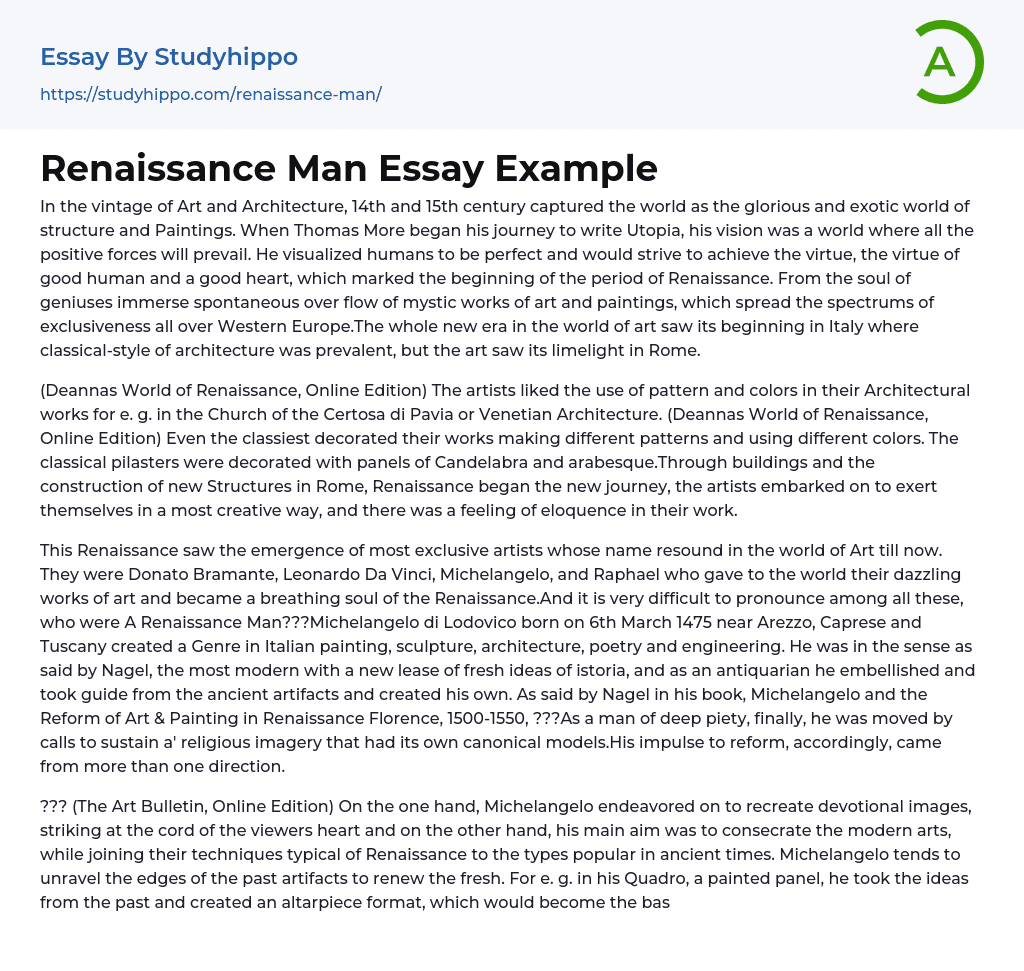During the era of Art and Architecture, the 14th and 15th century stood out as a time of magnificent and unique structures and paintings. Thomas More's journey to create Utopia envisioned a world where positive forces would thrive, where humans would strive for perfection, embodying good virtues and a good heart. This was the start of the Renaissance period, where geniuses created an outpouring of mystic works of art and paintings that spread throughout Western Europe. Italy, with its prevailing classical-style architecture, marked the beginning of the new era, with Rome as the epicenter of this artistic movement.
(Deannas World of Renaissance, Online Edition) During the Renaissance, artists incorporated pattern and color into their architectural works, such as in the Church of the Certosa di Pavia and Venetian Architecture. Even the most sophisticated artists added decorative touches to their creation
...s by utilizing various patterns and colors. The traditional pilasters were adorned with panels featuring Candelabra and arabesque designs. As the Renaissance introduced new construction projects in Rome, artists began to explore their creativity in exciting ways, resulting in eloquent work.
During the Renaissance, a group of artists emerged who are still renowned in the art world today: Donato Bramante, Leonardo Da Vinci, Michelangelo, and Raphael. It's difficult to determine which of them was the quintessential Renaissance Man- however, Michelangelo di Lodovico, born on March 6, 1475 near Arezzo, Caprese, and Tuscany, created works in a variety of fields including Italian painting, sculpture, architecture, poetry, and engineering. He was considered a modernist who brought a fresh perspective to the genre of istoria and drew inspiration from ancient artifacts to create his own unique style. According to Nagel'
book "Michelangelo and the Reform of Art & Painting in Renaissance Florence, 1500-1550," his deep religious piety influenced his desire to sustain religious imagery that followed canonical models. He also had an impulse to reform that came from multiple directions.
Michelangelo had two goals - to recreate devotional images that will touch the viewers' heart and to consecrate modern arts by combining Renaissance techniques with ancient styles. He renewed past artifacts by unraveling their edges and creating new forms, such as an altarpiece format inspired by past ideas and used as the basis for the "gallery picture" in his Quadro painted panel. He made devotional images secular, but still uniquely shaped in a way that offers new ways of devotion. (Source: The Art Bulletin, Online Edition)
Raphael, one of the prominent figures in the Renaissance movement alongside Leonardo da Vinci, Michelangelo, and Titian, made a significant impact on Western art history. The Art Bulletin's Online Edition notes that he introduced a unique genre that embodies conflicting values and represents an individual artistic culture. During his stint from 1504 to 1508 in Florence, Raphael crafted altarpieces for Citta di Castello and Perugia while producing remarkable portraits and devotional paintings of the Holy Family. Nevertheless, it was his masterpiece fresco - the Stanze of the papal apartments in Vatican Palace (1508) - together with smaller oil paintings and notable altarpieces that serve as his enduring legacy. Raphael's contribution cemented his stature as one of history's most ingenious artists.
Leonardo Da Vinci (1452-1519) was a remarkable individual of the Renaissance period, exhibiting exceptional abilities in painting, sculpture, engineering, science and invention. He transformed the use of drawing as a scientific tool.
His artistic talent conveyed knowledge more effectively than words. Da Vinci's innovative use of Chiascuro highlighted differences between light and shadow, while his unique method sfumato blended hues and tones to create breathtaking landscapes.
The portrait of Mona Lisa is a renowned example of the effect, which is widely regarded as one of the most famous portraits in Western art and a masterpiece that combines evocative portraiture with mastery of Sfumato technique. During the Renaissance period, portraiture gained dominance in art due to rising individualism, resulting in nobles, princes, popes, and other individuals getting themselves painted for posterity. Leonardo Da Vinci's scientific observations aided in enhancing expressiveness in his paintings while adhering more closely to reality.
Both Kellard's Online Edition and the BBC online report highlighted Leonardo da Vinci's remarkable abilities in blending drawing, color, perspective, and lighting with technical knowledge. Additionally, "The Last Supper," created between 1495 to 1497 at the Monastery of Santa Maria delle Grazie in Milan, exemplified the pinnacle of expression during the high renaissance period. This masterpiece established a benchmark for others to emulate and showcased da Vinci's exceptional talents.
Leonardo da Vinci was a skilled artist who depicted a range of human emotions in his artwork, including anger, fear, pity, aggression, and depression. He is considered the ultimate representative of the Renaissance period due to his exceptional achievements in both art and science. While other Renaissance artists like Michelangelo and Raphael also made significant contributions during this time, Leonardo's expertise across all areas of these disciplines made him an icon of the intellectual ideals and values of this era.
Sources: http://www.bbc.co.uk/history/historic_figures/da_vinci_leonardo.shtmlhttp://arthistory.about.com/cs/arthistory10one/a/high_ren_2.htm
- Creativity essays
- Art History essays
- Theatre essays
- Pastoral essays
- Visual Arts essays
- Postmodernism essays
- Symbolism essays
- ballet essays
- Color essays
- Modernism essays
- Mona Lisa essays
- Work of art essays
- Body Art essays
- Artist essays
- Cultural Anthropology essays
- Ethnography essays
- Aesthetics essays
- Realism essays
- Heritage essays
- Harlem Renaissance essays
- Concert Review essays
- Voice essays
- Theatre Of The Absurd essays
- Playwright essays
- Scotland essays
- Tennessee williams essays
- Design essays
- Graffiti essays
- Graphic essays
- Typography essays
- Painting essays
- Photography essays
- Sculpture essays
- Architecture essays
- Interior design essays
- Arch essays
- Area essays
- Tattoo essays
- Pablo Picasso essays
- Vincent Van Gogh essays
- Michelangelo essays
- Frida Kahlo essays
- John Locke essays
- 9/11 essays
- A Good Teacher essays
- A Healthy Diet essays
- A Modest Proposal essays
- A&P essays
- Academic Achievement essays
- Achievement essays




